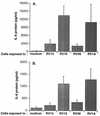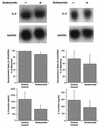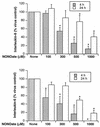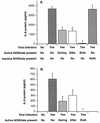Nitric oxide inhibits rhinovirus-induced cytokine production and viral replication in a human respiratory epithelial cell line
- PMID: 9444985
- PMCID: PMC124563
- DOI: 10.1128/JVI.72.2.934-942.1998
Nitric oxide inhibits rhinovirus-induced cytokine production and viral replication in a human respiratory epithelial cell line
Abstract
To better understand the early biochemical events that occur in human rhinovirus (HRV) infections, we examined the kinetics and mechanisms of interleukin-8 (IL-8) and IL-6 production from infected epithelial cells. Several HRV strains caused IL-8 and IL-6 production, but HRV-16 induced maximal IL-8 and IL-6 mRNA expression and protein production more rapidly than did HRV-14, despite similar rates of replication of the two viral strains. Viral induction of cytokine mRNA does not require new protein synthesis, since it was unaffected by cycloheximide treatment. The potent glucocorticoid budesonide did not affect viral replication or cytokine mRNA induction but modestly inhibited cytokine protein production. Interestingly, the nitric oxide donor 3-(2-hydroxy-2-nitroso-1-propylhydrazino)-1-propanamine (NONOate) inhibited both rhinovirus replication and cytokine production in a dose-dependent fashion without reducing levels of cytokine mRNA. The NONOate effects were due to release of nitric oxide, because NONOate that had been depleted of its nitric oxide content had no effect. Thus, nitric oxide may play an important anti-inflammatory and antiviral role in colds and nitric oxide donors may represent a novel therapeutic approach.
Figures









Similar articles
-
Nitric oxide inhibits human rhinovirus-induced transcriptional activation of CXCL10 in airway epithelial cells.J Allergy Clin Immunol. 2009 Jan;123(1):201-208.e9. doi: 10.1016/j.jaci.2008.09.041. Epub 2008 Nov 4. J Allergy Clin Immunol. 2009. PMID: 18986693
-
Nitric oxide inhibits rhinovirus-induced granulocyte macrophage colony-stimulating factor production in bronchial epithelial cells.Am J Respir Cell Mol Biol. 2001 Mar;24(3):317-25. doi: 10.1165/ajrcmb.24.3.4131. Am J Respir Cell Mol Biol. 2001. PMID: 11245631
-
Rhinovirus infection of primary cultures of human tracheal epithelium: role of ICAM-1 and IL-1beta.Am J Physiol. 1997 Oct;273(4):L749-59. doi: 10.1152/ajplung.1997.273.4.L749. Am J Physiol. 1997. PMID: 9357849
-
Asthma, viruses, and nitric oxide.Proc Soc Exp Biol Med. 1999 Mar;220(3):123-32. doi: 10.1046/j.1525-1373.1999.d01-19.x. Proc Soc Exp Biol Med. 1999. PMID: 10193439 Free PMC article. Review.
-
Nitric oxide and the common cold.Curr Opin Allergy Clin Immunol. 2005 Feb;5(1):37-42. doi: 10.1097/00130832-200502000-00008. Curr Opin Allergy Clin Immunol. 2005. PMID: 15643342 Review.
Cited by
-
The role of respiratory viruses in acute and chronic asthma.Clin Chest Med. 2000 Jun;21(2):289-300. doi: 10.1016/s0272-5231(05)70267-7. Clin Chest Med. 2000. PMID: 10907589 Free PMC article. Review.
-
Rhinovirus Induces Basolateral Release of IL-17C in Highly Differentiated Airway Epithelial Cells.Front Cell Infect Microbiol. 2020 Mar 13;10:103. doi: 10.3389/fcimb.2020.00103. eCollection 2020. Front Cell Infect Microbiol. 2020. PMID: 32232015 Free PMC article.
-
Innate immune response to viral infection of the lungs.Paediatr Respir Rev. 2008 Dec;9(4):243-50. doi: 10.1016/j.prrv.2008.04.001. Epub 2008 Oct 15. Paediatr Respir Rev. 2008. PMID: 19026365 Free PMC article. Review.
-
Rhinovirus infection interferes with induction of tolerance to aeroantigens through OX40 ligand, thymic stromal lymphopoietin, and IL-33.J Allergy Clin Immunol. 2016 Jan;137(1):278-288.e6. doi: 10.1016/j.jaci.2015.05.007. Epub 2015 Jun 19. J Allergy Clin Immunol. 2016. PMID: 26100084 Free PMC article.
-
PGC-1α mediates a metabolic host defense response in human airway epithelium during rhinovirus infections.Nat Commun. 2021 Jun 16;12(1):3669. doi: 10.1038/s41467-021-23925-z. Nat Commun. 2021. PMID: 34135327 Free PMC article.
References
-
- Akiro S, Hirano T, Taga T, Kishimoto T. Biology of multifunctional cytokines: IL 6 and related molecules (IL 1 and TNF) FASEB J. 1990;4:2860–2867. - PubMed
-
- Arola M, Ziegler T, Puhakka H, Lehtonen O P, Ruuskanen O. Rhinovirus in otitis media with effusion. Ann Otol Rhinol Laryngol. 1990;99:451–453. - PubMed
Publication types
MeSH terms
Substances
Grants and funding
LinkOut - more resources
Full Text Sources
Other Literature Sources

